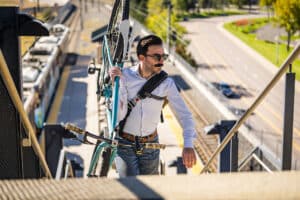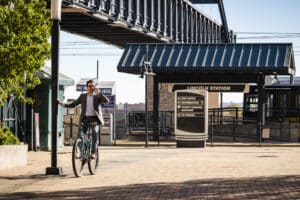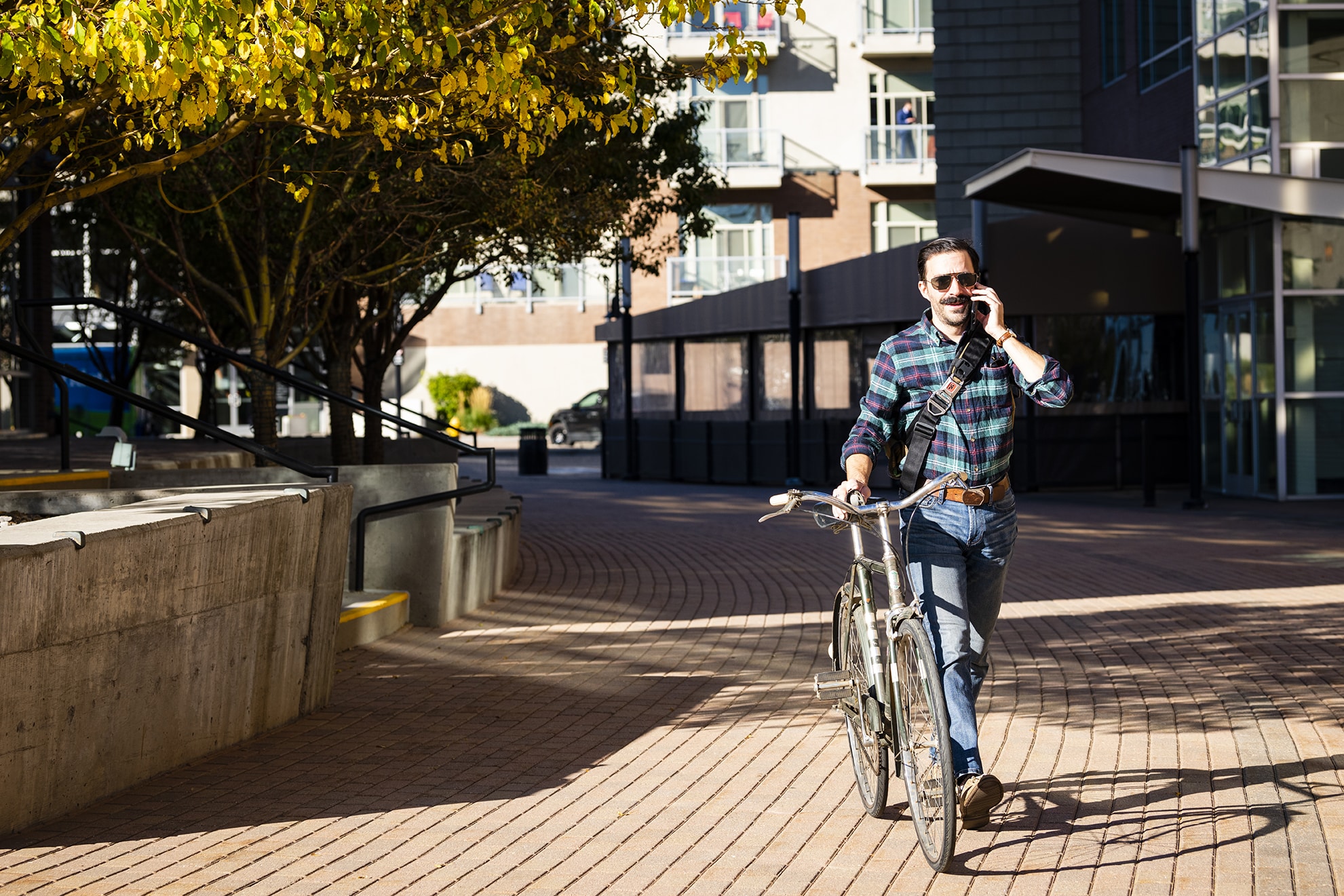We often throw around a lot of mobility-related terms and phrases in this blog. Terms like microtransit and rightsizing — referring to micromobility — are words that are frequently used by our team, but are uncommon outside the world of transportation. In this blog, we dive into the idea of micromobility, what micromobility is, and the value of creating sustainable and effective micromobility solutions. In doing so, we hope to provide some insight as to why we spend so much time working on and discussing these concepts.
What Is Micromobility?
You likely already know what micromobility is, but simply haven’t heard the term. Micromobility refers to transportation using lightweight, single-person vehicles such as bicycles, e-bikes, and e-scooters, which are often borrowed or part of a short-term use, self-service rental program for use within a town or city.
As urban areas began to seek sustainable solutions to traffic congestion and pollution in the late 20th century, micromobility emerged as a better connection between people and public transportation. The 2010s saw a significant increase of usage with the advent of dockless bike and electric scooter sharing services. This helped revolutionize urban transport, providing convenient, inexpensive alternatives for traveling short distances, such as the first and last mile of a public transit commute.
Micromobility options play an important role in urban and suburban transportation. They offer eco-friendly ways to travel short distances, helping to reduce traffic jams and lower carbon emissions. Even more, they make it easier for everyone to get around and connect with public transit. Bridging these gaps is especially important as our population grows because it ensures everyone has access to reliable transportation. This not only empowers communities by promoting social equity and economic growth but also supports sustainable urban and suburban development.

Forms of Micromobility
There are many micromobility options, which can range from partially human-powered to fully electric. Most people are familiar with bikes, e-bikes, and e-scooters. But, other forms of micromobility include cargo bikes, skateboards, kick scooters, and rickshaws. There are also new forms of micromobility such as electric one-wheels and vehicles that are a cross between a car and a bike. Whether you’re an avid cyclist, skateboard enthusiast, or scooter sprinter, there’s a micromobility option for just about everyone. If you feel intimidated by a new option, go for the one most familiar and enjoy the ride.
Benefits of Micromobility
In the Denver South region, we work together to build and enhance our neighborhoods, businesses, and environment, and improving our transportation system does just that. Micromobility offers significant environmental benefits and helps reduce urban congestion. By providing efficient alternatives to motorized vehicles for short-distance travel, micromobility options lessen the reliance on fossil fuels. This, in turn, lowers greenhouse gas emissions and improves overall air quality. With road congestion always a concern in our area, micromobility options can help solve that by taking up less space on roads and allowing users to navigate through traffic easier. It’s a winning combination. Another bonus is decreased wear and tear on our roads, which equals a smoother ride. But the benefits don’t stop there. The integration of micromobility with public transportation systems enhances overall transit efficiency, encouraging more people to choose more sustainable travel methods, which fosters greener and more livable cities.
In Denver South, we tend to be more active, however, our society as a whole has become more sedentary. Another upside of micromobility options is a positive impact on health and lifestyle as they promote physical activity along with convenient, flexible travel options. Additionally, micromobility provides a practical solution for last-mile transportation by reducing dependency on vehicles and enhancing the accessibility of public transit.
What Is Suburban Micromobility?
Suburban micromobility refers to transportation solutions and modes of travel that are designed to address the specific needs of suburban areas. It focuses on providing efficient and convenient transportation options for shorter distances within suburban communities.
We asked Daniel Hutton, Director of Transportation & Mobility, for his take: “Unlike urban areas, where public transportation networks are more extensive and walking or cycling may be feasible for many trips, suburban areas are often characterized by lower population density, longer distances between destinations, and less developed infrastructure for alternative modes of transport. However, e-bikes, e-scooters, and smaller affordable vehicles are providing new ways of getting around the region and opening up new possibilities for commuters.”
In short, our suburban micromobility solutions aim to bridge this gap and offer sustainable and practical alternatives to traditional modes of transportation. With a focus on cultivating regional connectivity in the region, we work across jurisdictions to better move people across city lines via micromobility solutions that suit their needs and lifestyle. This supports our long-term goal – working alongside our jurisdictional partners to help provide residents, commuters, and businesses with convenient, affordable, and sustainable transportation options.

Challenges and Concerns with Suburban Mobility
Like any change, micromobility and suburban mobility bring their own set of challenges and concerns. Some of the major, and valid, issues include safety concerns and infrastructure challenges. As part of the community, we care about and share these concerns, which is why we are working diligently with local partners and jurisdictions to solve for them.
Safety Concerns
As the use of micromobility transportation increases, so does the potential for accidents and injuries, which raises safety concerns. We are, of course, aware of these concerns, which is why we are working to help reduce those potential problems. Collisions and accidents are often due to inexperienced riders, lack of proper protective gear, and inadequate road conditions. Ensuring safety requires implementing safety standards, such as mandatory helmet use, speed limits, and designated lanes to protect both riders and pedestrians.
Regulatory concerns also encompass the need for clear guidelines on the usage, parking, and maintenance of micromobility vehicles. Micromobility users must be aware of where they may use the vehicle — sidewalk, bike lane, or road — and comply with the guidelines. Issues such as cluttered sidewalks from improperly-parked scooters are another issue that pose problems for pedestrians. An additional issue of concern is the need for regular maintenance checks to ensure vehicle safety. It’s important to establish clear liability frameworks that address accidents and injuries, providing a legal basis for accountability among riders, operators, and municipalities. These regulatory measures are vital for the integration of micromobility options into existing transportation systems and it’s why we continue to work closely with local partners.
Infrastructure Challenges
 Integrating micromobility options into an existing infrastructure isn’t without some challenges. Infrastructure challenges include the need for careful city planning and adaptation to accommodate these modes of transportation, allowing for seamless integration into the current transportation system of motorized vehicles and public transportation. Many urban and suburban areas lack the necessary infrastructure, such as dedicated bike lanes, secure parking spaces, and smooth road surfaces, to ensure the safe and efficient use of micromobility transportation. Integrating micromobility into existing roadways does require a significant investment. It also involves reevaluating traffic flow and prioritizing the safety of micromobility users and pedestrians.
Integrating micromobility options into an existing infrastructure isn’t without some challenges. Infrastructure challenges include the need for careful city planning and adaptation to accommodate these modes of transportation, allowing for seamless integration into the current transportation system of motorized vehicles and public transportation. Many urban and suburban areas lack the necessary infrastructure, such as dedicated bike lanes, secure parking spaces, and smooth road surfaces, to ensure the safe and efficient use of micromobility transportation. Integrating micromobility into existing roadways does require a significant investment. It also involves reevaluating traffic flow and prioritizing the safety of micromobility users and pedestrians.
Integration with public transport is another critical aspect of successfully incorporating micromobility solutions. Connecting micromobility options with bus, train, and subway systems can enhance the convenience and appeal of opting for micromobility transportation. This, in turn, makes them practical alternatives for using motorized vehicles for the first and last mile of commutes. While micromobility transportation requires careful planning, the benefits of effective integration are significant — reduced traffic congestion, decreased carbon emissions, and an interconnected transportation network.
Improving the Quality of Life Through Micromobility
Suburban and urban micromobility represent an innovative approach to enhancing transportation choices. By integrating options like bikes, e-bikes, and e-scooters, we can provide sustainable, affordable, and practical alternatives to traditional transportation methods. While there are challenges, such as safety and infrastructure concerns, these can be addressed through thoughtful planning, collaboration with local partners, investment in dedicated spaces, and clearly outlined regulatory frameworks.
At Denver South, we aim to help our community, from businesses to local governments, envision a safe and connected transportation future by providing a third option, beyond driving and pedestrian, and rethinking how these systems can enhance the future of our communities. We know a flourishing micromobility network will be key to this future, as we seek to improve mobility (and therefore quality of life) in Denver South.

